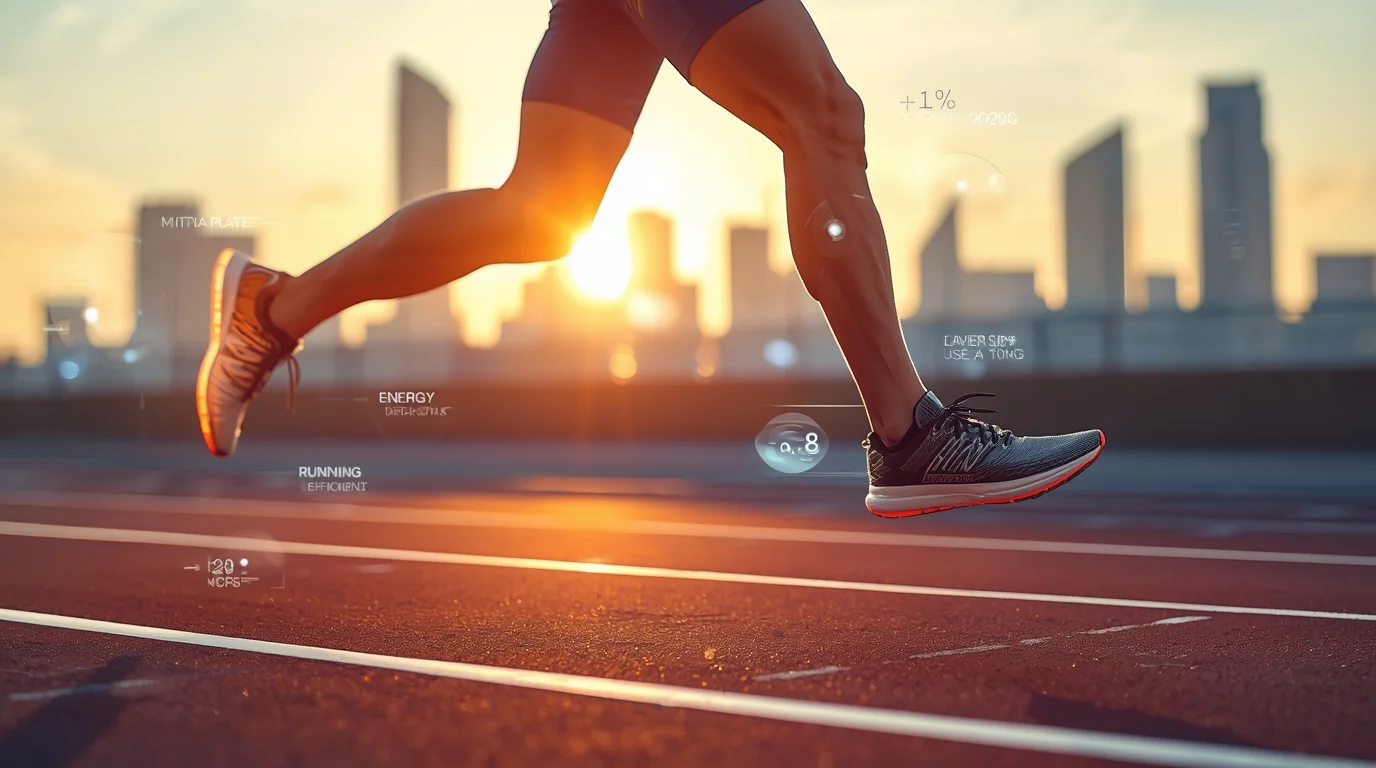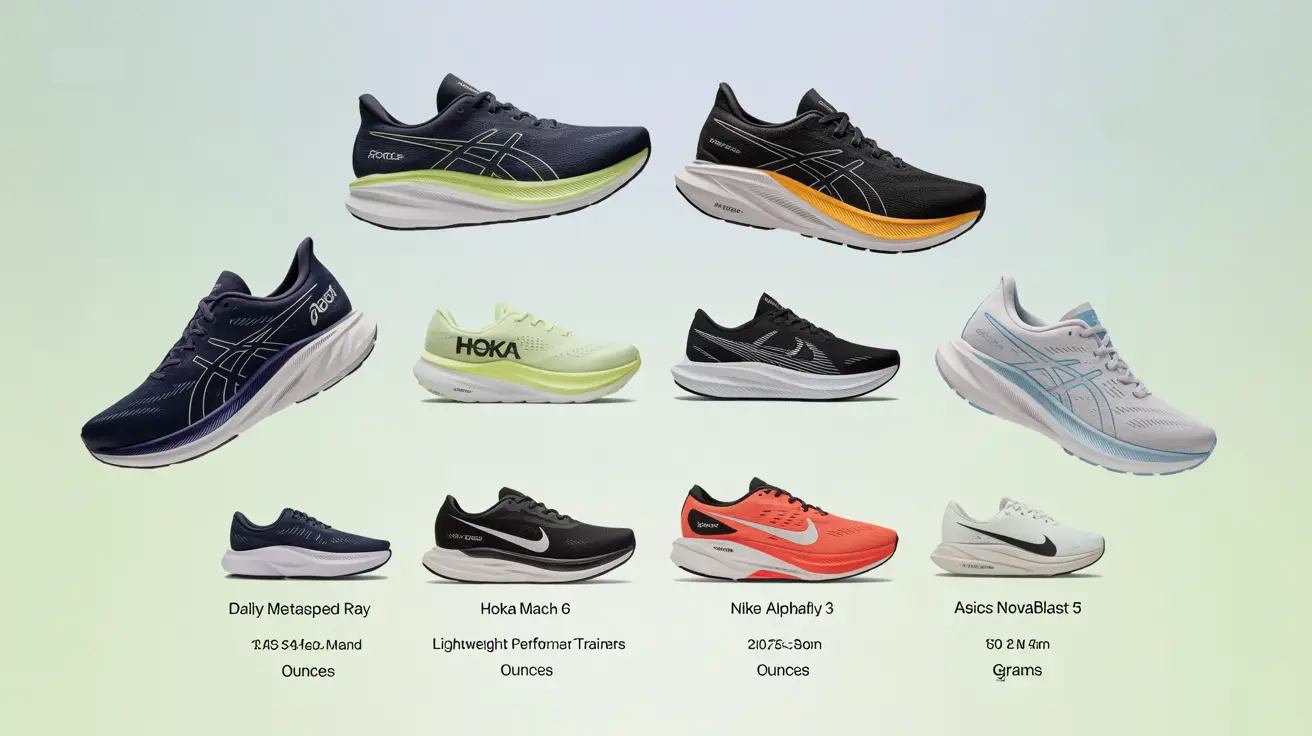

Running shoe weight directly affects performance by increasing aerobic demand. Research consistently shows that adding 100 grams per shoe increases oxygen consumption by approximately 1%, translating to measurably slower race times. However, shoes that are too light sacrifice cushioning, paradoxically increasing energy expenditure as muscles work harder to absorb impact.

Dr. Jack Daniels' pioneering 1980s research for Nike established the foundational 1% rule: for every 100 grams added to each shoe, aerobic demand increases by 1%. This finding has been replicated across multiple studies spanning four decades.
A comprehensive 2020 study published in Frontiers in Physiology tested 18 competitive runners in 3,000-meter time trials with varying shoe weights. Performance times increased by an average of 0.78% per 100g of added weight, confirming the original Nike findings with modern methodology.
More recent 2025 research revealed that the weight penalty intensifies at higher intensities. Adding 100g per shoe worsened running economy by 7.40% at 85% of ventilatory threshold and 10.20% at 95%, significantly greater impairment than at easy paces.
Key Insight: Bill Bowerman, Nike co-founder, estimated that removing 1 ounce from a shoe results in a 55-pound reduction in lift over 1 mile. Over marathon distance, this cumulative effect becomes substantial.Dr. Daniels' research uncovered a critical nuance: when shoe weight dropped too low, running economy paradoxically worsened. This occurs because inadequate cushioning forces muscles to absorb greater landing shock, increasing energy expenditure.
Running economy follows a U-shaped relationship with shoe weight:
Too Heavy: Increased mass raises aerobic demand through mechanical disadvantage
Optimal Range: Balance between weight penalty and cushioning benefit
Too Light: Insufficient shock absorption increases muscular workload
Research demonstrates proper cushioning can improve running economy by 3-4%, potentially offsetting the 1% penalty from moderate weight increases. The introduction of PEBA foams in 2017 fundamentally changed this equation, enabling shoes with 40mm+ stack heights weighing under 7 ounces, previously impossible with traditional EVA foam.

The running shoe market has evolved dramatically with advanced foam technologies enabling lighter construction without sacrificing cushioning:
Daily Trainers (Men's Size 9 / Women's Size 7):
Men: 9-10 oz average
Women: 7-8 oz average
Lightweight Performance Trainers:
Men: ≤8.5 oz
Women: ≤6.9 oz
Racing Shoes:
Men: 6-7 oz
Women: 5-6 oz
Notable 2025 Models:
ASICS Metaspeed Ray: 4.55 oz (129g) - Elite marathon racer
Hoka Mach 6: 7.8 oz - Lightweight daily trainer
Nike Alphafly 3: 7.2 oz with 55mm stack - Super shoe technology
ASICS Novablast 5: 9.8 oz - Versatile neutral trainer
Optimal shoe weight depends on individual factors, including experience, body weight, biomechanics, and training phase.
Ideal Candidates for Lightweight Shoes (Under 7 oz):
Elite/experienced runners with efficient form
Lighter runners (under 150 lbs)
Track work and speed sessions
Racing distances from 5K to marathon
When Heavier Shoes (9-12 oz) Make Sense:
Beginners developing musculoskeletal adaptations
Heavier runners (over 180 lbs) require robust cushioning
High mileage training and recovery runs
Injury-prone athletes need protective features
Critical Research Finding: A 26-week study found that runners weighing over 187 pounds who trained in lightweight shoes were over 3 times more likely to sustain injuries than those who trained in conventional trainers. This emphasizes adequate cushioning for heavier runners.
Ground reaction forces during running reach 2-3 times body weight. For a 200-pound runner versus a 150-pound runner, this difference accumulates to substantial additional stress over marathon distance.
Weight-Specific Guidelines:
Under 150 lbs: Freedom to explore the full weight spectrum, including racing flats
150-180 kg: Daily trainers 8-10 oz, racing shoes 6-7 oz
180-220 kg: Daily trainers 10-12 oz, avoid ultra-minimal designs
Over 220 lbs: Maximum cushioning essential, 11-13 oz range
High-density foams maintain performance characteristics across wider weight ranges, though they typically add 0.5-1.5 oz. Brands like JD Sports and New Balance specifically engineer models for heavier runners with firmer, more resilient foam blends.
Consider These Five Factors:
Primary Goal: Racing (6-8 oz) vs base building (8-10 oz) vs injury recovery (10-12 oz)
Experience Level: Beginners need heavier protective shoes; advanced runners have more freedom
Body Weight: Use category recommendations above
Injury History: Clean history allows experimentation; previous injuries require a conservative approach
Weekly Mileage: Higher volume justifies investment in multiple specialized pairs
The Two-Shoe Minimum Strategy:
Biomechanics research supports rotating at least two models to vary stress patterns and allow midsole foam to recover between runs (24-48 hours). Example rotation:
Easy/Long Runs: Cushioned trainer 9-10 oz (60% of mileage)
Tempo/Intervals: Lightweight trainer 7-8 oz (30% of mileage)
Race Day: Racing flat 6-7 oz (race only)
If currently training in 10-11 oz shoes and interested in lighter options, follow this progression:
Weeks 1-4: Introduce a lightweight trainer for 20% of weekly mileage on easy runs.
Weeks 5-8: Expand to tempo runs, maintain heavy shoes for long runs.
Weeks 9-12: If no discomfort, rotate lightweight shoes to 50% of training.
Week 13+: Consider racing flats for specific events
This gradual adaptation allows connective tissues to strengthen in response to reduced cushioning stimulus.
The 1% Rule: Adding 100 grams per shoe increases aerobic demand by 1%, with a 0.78% improvement in performance time confirmed across studies.
Cushioning Matters More: Proper midsole cushioning improves running economy by 3-4%, often outweighing the benefits of extreme weight reduction.
No Universal Optimum: Best shoe weight depends on body weight, experience level, injury history, and training purpose rather than blanket recommendations.
Modern Materials Changed Everything: PEBA foams and carbon plates enable 40mm+ stacks weighing under 7 ounces, eliminating traditional trade-offs.
Heavier Runners Need Protection: Athletes over 187 lbs face 3x higher injury risk in lightweight shoes lacking adequate cushioning.
1) What is the ideal weight for running shoes?
For daily trainers, men should target 9-10 ounces (size 9) and women 7-8 ounces (size 7). Racing shoes are typically 6-7 oz for men, 5-6 oz for women. Heavier runners benefit from 10-12 oz shoes.
2) Do carbon-plated shoes make you faster despite their weight?
Yes. Modern super shoes with carbon plates and PEBA foam improve running economy by 4-5% according to research, despite weighing 7-8 ounces. The mechanical advantages outweigh the weight penalty.
3) Can beginners use lightweight running shoes?
Beginners should prioritize cushioning over minimal weight. Developing musculoskeletal systems and inefficient form increase injury risk in lightweight shoes. A 26-week study found that injury rates were 3 times higher among heavier runners in lightweight trainers.
4) How can I tell if my shoes are too heavy or too light?
Too heavy: sluggish leg turnover, reduced responsiveness. Too light: excessive calf/Achilles soreness, fatigue on easy runs. Optimal shoes feel protective yet responsive, with no noticeable weight during training.
5) Should I use different shoe weights for different runs?
Yes. Use heavier cushioned trainers (9-11 oz) for easy runs and long runs where recovery matters. Transition to lighter shoes (7-9 oz) for tempo runs, where responsiveness is key. Save racing flats (5-7 oz) for competitions.
No reviews yet!